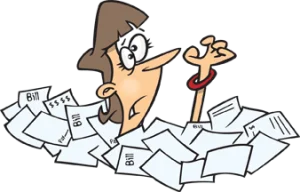Sample Business Transactions
Business Transactions
Sample Business Transactions
In this lesson and future lessons we are going to stray away from analyzing and recording transactions using the “Big Accounts” and start using the detail accounts to record and analyze our business transactions.

Let’s take a step in this direction by setting up a simple chart of accounts for ABC Mowing.
Simple Chart Of Accounts For ABC Mowing
Assets
Account Name:Cash
Description:Currency and checks and balance in bank
Account Name:Cash
Description:Currency and checks and balance in bank
Account Name:Accounts Receivable
Description:Amounts due from customer’s for services rendered
Description:Amounts due from customer’s for services rendered
Account Name:Inventory-Office Supplies
Description:On hand supplies of such items as copier & computer paper, pens, pencils and other office supplies
Description:On hand supplies of such items as copier & computer paper, pens, pencils and other office supplies
Account Name:Mowing Equipment
Description:Mowers purchased
Description:Mowers purchased
Liabilities
Account Name:Accounts Payable
Description:Amounts owed suppliers for business purchases and expenses
Account Name:Accounts Payable
Description:Amounts owed suppliers for business purchases and expenses
Account Name:Note Payable-Bank
Description:Mortgages and loans owed to bank
Description:Mortgages and loans owed to bank
Equity
Account Name:Owner’s Capital
Description:Amounts invested by owner and earned by operations
Account Name:Owner’s Capital
Description:Amounts invested by owner and earned by operations
Account Name:Owner’s Draws
Description:Amounts withdrawn by owner for personal expenses
Description:Amounts withdrawn by owner for personal expenses
Revenue
Account Name:Mowing Revenues
Description:Earnings from mowing yards
Account Name:Mowing Revenues
Description:Earnings from mowing yards
Expenses
Account Name:Advertising Expense
Description:Expenditures for TV, radio, newspaper, and other promotions.
Account Name:Advertising Expense
Description:Expenditures for TV, radio, newspaper, and other promotions.
Account Name:Mulch Expense
Description:Expenditures for mulch used for yard work
Description:Expenditures for mulch used for yard work
These our the Detail Accounts that we'll be using to record ABC Mowing's Transactions in future Lessons.
Source Documents
The original sources of information that provide documentation (proof) that a transaction has occurred are sales invoices (tickets), invoices from suppliers, contracts, checks written and checks received , promissory notes, and various other types of business documents. These documents provide us with the information needed to record our financial transactions in our bookkeeping records.
Typical Examples of Source Documents:
Invoice-a business document showing the names and addresses of the buyer and the seller; the date and terms of the sale; the description, quantity, unit price, and total price of goods purchased or sold and the method of delivery.
Selling business refers to this document as a Sales Invoice.
Buying business refers to this document as a Supplier Invoice.
Receiving Report-A document originated by the buying business listing the quantities and condition of the goods and/or services received from a supplier.
Sales Order-A documented originated by the seller listing the goods and/or services ordered by a customer and other information such as prices and delivery dates.
Purchase Order-A document originated by the purchaser (buyer) requesting the supplier to ship goods or perform services.
Check Book-Formal record of all checks written, deposits, bank charges, and miscellaneous charges and credits.
Check-A written order directing a bank to pay cash from the account of the writer (drawer) of the check.
Typical Types Of Business Transactions and the Debits and Credits and Accounts Used To Record Them
In a typical business transaction we get something and we give up something.
Sale-Sell goods and/or services
Cash Sale-customer pays at the time of sale
The business gets cash or a check from their customer and gives up a product or service
to their customer.
Accounts Used:
Debit: Cash
Credit: Sales
On Account Sale-business allows the customer time to pay
The business gets a promise to pay from their customer and gives up a product or service
to their customer.
Accounts Used:
Debit: Accounts Receivable
Credit: Sales
Purchase goods and/or services
Cash Purchase-business pays the supplier at the time of purchase
The business gets a product or service from their supplier and gives up cash or a check
to their supplier.
Accounts Used:
Debit: Expense or Inventory Account
Credit: Cash
On Account Purchase-supplier allows the business time to pay
The business gets a product or service from a supplier and gives up a promise to pay to their supplier.
Accounts Used:
Debit: Expense or Inventory Account
Credit: Accounts Payable
Pay Supplier Charge Purchases -pay suppliers for products and/or services that we promised to pay for later (charge).
The business gets the amount of their promise to pay the supplier reduced and gives up cash or a check.
Accounts Used:
Debit: Accounts Payable
Credit: Cash
Receive Customer Charge Payments -receive payments from a customer that promised to pay us later (charge sale).
The business gets cash or a check from their customer and gives up (reduces the amount of) their customer’s promise to pay.
Accounts Used:
Debit: Cash
Credit: Accounts Receivable
Borrow Money (Loans) –receive loan from a creditor with payment terms
The business gets cash or equipment and gives up a promise to pay.
Accounts Used:
Debit: Cash or Equipment
Credit: Note Payable
Repay a Loan – business makes payments to creditor
The business gets the amount of their promise to pay reduced and gives up cash or a check.
Accounts Used:
Debit: Note Payable
Credit: Cash
Draw -payments made to owner(s)
The business gets the owner’s claim to the business assets reduced and gives up cash or a check.
Accounts Used:
Debit: Owner’s Draw
Credit: Cash
Payroll (not covered in this tutorial)
The business gets services from their employees and gives up a check.
Accounts Used:
Debit: Salary & Wages Expense
Credit: Cash
ABC's Transactions

